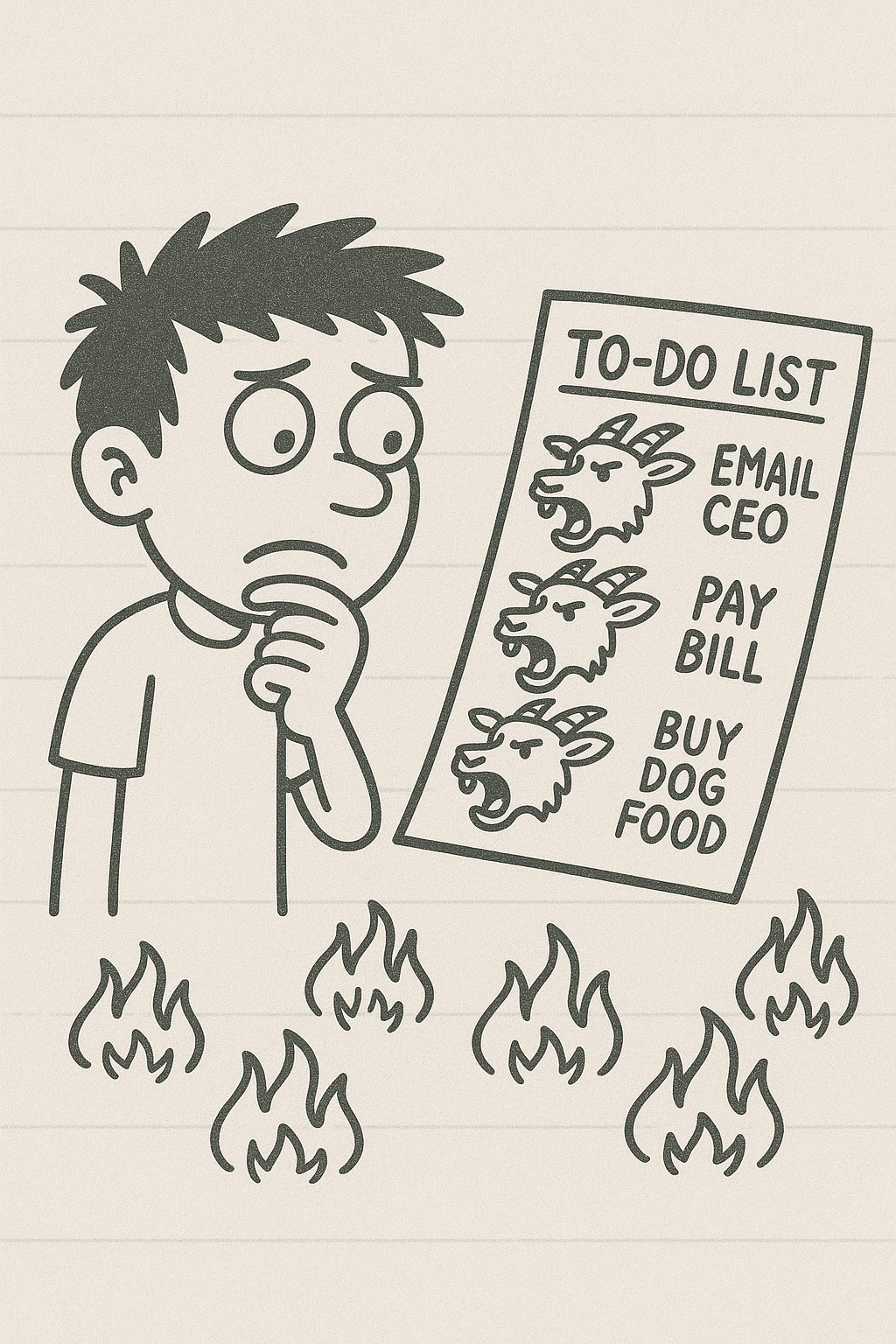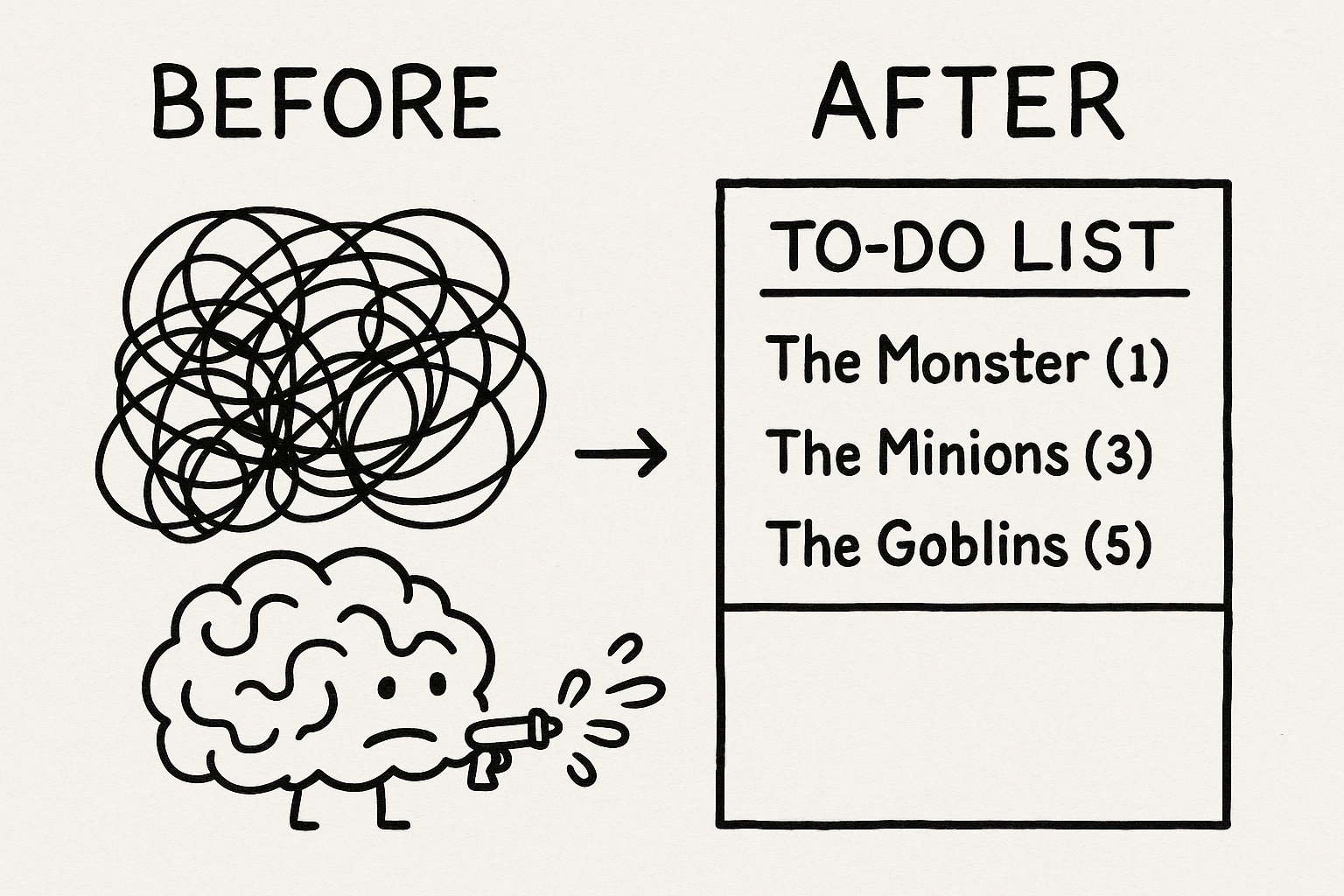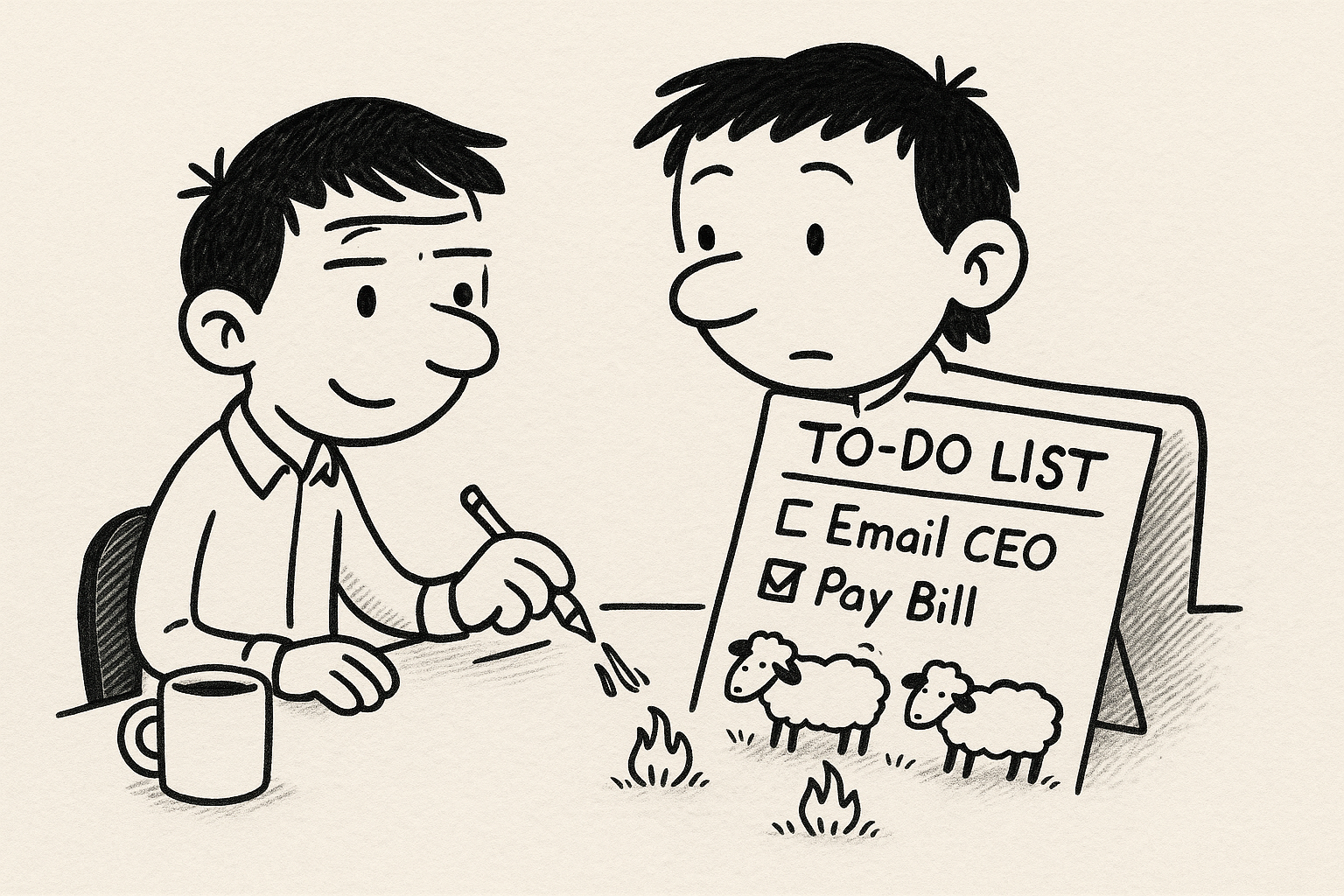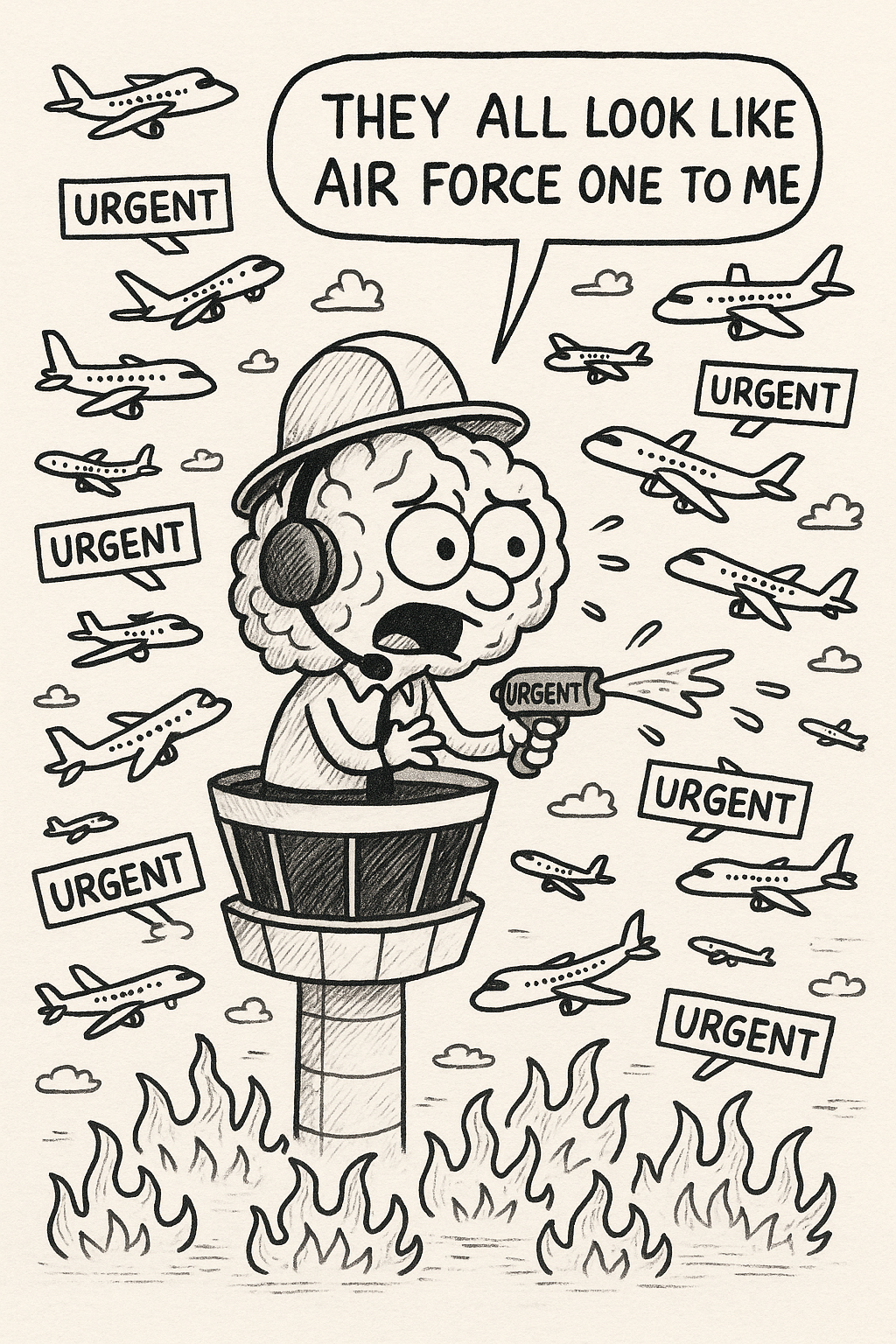
📖 The Priority Collapse
Me, 9:00 AM: “Okay, let’s look at the to-do list. Simple.”
- Email CEO about the Project Phoenix deadline.
- Pay the overdue electric bill.
- Remember to buy dog food.
My Brain, 9:01 AM: Threat assessment complete. All three tasks have been assigned a priority level of “CATASTROPHIC FAILURE IMMINENT.” If I don’t email the CEO, I’m fired. If I don’t pay the bill, we live in darkness. If I don’t buy the food, the dog will wither away. The panic is equal. The urgency is identical.
Me, 12:37 PM: After three hours of frantic, anxious paralysis, I have accomplished none of the critical tasks. Instead, I have alphabetized the spices in my kitchen cabinet, because that was a problem I felt I could solve. The wall of screaming tasks remains untouched.

🔬 SCIENCE ALERT
🧠 The Brain’s Broken Volume Knob
If your brain’s alarm system treats a typo in an email with the same panic as a house fire, you’re not being dramatic—you’re experiencing a core feature of ADHD. It boils down to two main glitches:
Neuro-sparknotes:
- Time Blindness: This is the main culprit. Your prefrontal cortex struggles to place events on a timeline. Without a clear sense of “later,” all impending tasks get collapsed into a single, terrifying category: “NOW.” And in the “NOW” category, everything feels like an emergency.
- Hierarchical Thinking Failure: Your brain’s executive functions, which are responsible for sorting tasks by importance, are impaired. It fails to assign different “value tags” to tasks. Modern digital tools, with their flat, chronological notification streams, actually make this worse by presenting every ping with the same visual weight.
🎮 SOLUTION QUEST: The ‘Forced Rank’ Protocol
To escape the urgency trap, you must bypass your brain’s faulty internal priority system and use an external, logical one.
- Step 1: The ‘Deadline-Only’ Sort
- Ignore your feelings of “importance.” Open your to-do list and re-order it based on one cold, hard metric: the external, hard deadline. The task due at 5 PM today is #1, even if it feels less “important” than the one due Friday. No exceptions. This is your new law. +10 Clarity Points.
- Step 2: The ‘1-3-5’ List
- If deadlines are vague, force a hierarchy. Each day, choose only: 1 big/hard thing, 3 medium things, and 5 small/easy things. This structure forces you to decide what truly matters and prevents the list from becoming an infinite wall of screaming. +15 Clarity Points.
- Step 3: Ask the ‘Triage Question’
- When you’re frozen, ask yourself one question: “What will cause the most objective damage in the next 24 hours if it is not done?” Not emotional damage—real-world damage (e.g., a late fee, a missed appointment). Do that one thing. You’ve just performed mental triage.

🔄 NARRATIVE REPLAY — “Take Two: The Triage”
Me, 2:00 PM: Okay, new plan. I look at my three screaming goats: CEO Email, Electric Bill, Dog Food.
I ask the Triage Question: What causes damage in the next 24 hours?
- The CEO email is important, but the deadline isn’t until tomorrow.
- The dog has enough food for tonight.
- The electric bill is due by midnight, or a late fee gets charged.
My Brain: But the CEO! The Dog! Me: Quiet, you. The bill is the triage priority.
Me, 2:07 PM: I paid the bill online. It took three minutes. A tiny wave of relief washed over me. The other two tasks still felt big, but they were no longer screaming. They were just… waiting their turn. For the first time all day, there was order.

Comprehensive FAQ: Navigating the ADHD “Urgency Trap”
Category 1: Understanding the “Why”
Q: Why does my brain’s panic button seem stuck on high for every single task? A: This is a classic ADHD experience. It’s not a personality flaw; it’s your brain’s wiring. Due to “time blindness” and executive function challenges, your brain struggles to sort tasks by importance and timeline. Without a clear hierarchy, it treats every item on your to-do list as a top-priority threat, triggering a constant state of low-grade panic.
Q: Is this feeling of constant urgency a core part of ADHD, or is it just anxiety? A: It’s often both, and they feed each other. ADHD provides the foundational issue (poor prioritization, time blindness). The anxiety is the emotional response to the chaos and the fear of “dropping the ball,” which you may have been criticized for in the past. The ADHD creates the fire, and the anxiety pours gasoline on it.
Q: Does “time blindness” really make a small task like “buy milk” feel as important as a big one like “finish project report”? A: Yes, precisely. Time blindness collapses the future. Your brain doesn’t accurately compute that the consequences of forgetting milk are minor and immediate, while the consequences of a late report are major and further away. It just sees two “undone” tasks in the “NOW” category, and both trigger an alert.
Q: Why do I get completely paralyzed by a simple to-do list? I know what to do, but I can’t move. A: This is “analysis paralysis,” and for the ADHD brain, it’s triggered by too many competing “urgent” signals. When every task is screaming for attention at the same volume, your executive function system gets overloaded and shuts down as a protective measure. It’s easier to do nothing than to choose from ten equally loud options.
Category 2: Practical Strategies & Prioritization
Q: What is the absolute first step when a to-do list feels like a wall of screaming? A: Triage with a single question: “What will cause a real, negative consequence today if I don’t do it?” This isn’t about importance; it’s about immediate damage control (e.g., a late fee, a missed appointment). Pick that one thing. The “screaming” from the other tasks is just a false alarm from your brain’s faulty fire detector.
Q: The ‘Deadline-Only’ sort sounds good, but what if none of my tasks have hard deadlines? A: This is where you have to create an artificial structure. Use the “1-3-5” method mentioned in the article, or rank tasks by “energy level.” Ask yourself: “Which task can I do right now with my current mental energy?” Sometimes, starting with a small, easy win (a “Goblin” task) is enough to build the momentum needed to tackle a bigger one.
Q: Are there any apps specifically designed to help with ADHD prioritization? A: While many to-do list apps can add to the overwhelm, some are built with ADHD in mind. Look for apps that allow you to: 1) Focus on only one task at a time (e.g., “single-tasking” mode). 2) Easily re-prioritize with drag-and-drop. 3) Use visual cues like colors or sizes to create a hierarchy. However, the physical sticky note often wins because of its simplicity and finite space.
Category 3: Interpersonal & Professional Scenarios
Q: My boss just sent me a list of 10 “urgent” tasks. How do I handle that without melting down? A: This is a perfect opportunity to manage expectations and get clarity. Use a collaborative script like: “This is a great list. To make sure I’m aligned with the team’s goals, which one or two of these are the highest priority for you right now?” This politely hands the overwhelming job of prioritization back to them and gives you a clear starting point.
Q: How do I explain to my partner that “take out the trash” feels as mentally demanding as “finish my work project” right now? A: Use an analogy. Try saying, “Imagine my brain is a computer with not enough RAM. When it has too many programs open, even a small one like ’take out trash’ can make the whole system freeze. It’s not that the task is hard; it’s that my system is already at 100% capacity.” This frames it as a capacity issue, not a value judgment on the task itself.
Category 4: Troubleshooting & Mindset
Q: I tried to prioritize, but I chose the “wrong” thing and wasted the whole day. How do I recover from that? A: First, acknowledge that there is no “wrong” choice when you’re starting from a state of paralysis. You broke the freeze. You took action. That is a win. The goal of these hacks isn’t perfect, 100% optimal productivity. The goal is to be more effective than you were yesterday. Forgive yourself, declare a “brain reboot,” and try again with the smallest possible task tomorrow.
Q: The anxiety from having so many ‘urgent’ tasks is exhausting. How do I manage the mental fatigue? A: Schedule “priority-free zones” into your day. This is a block of time (even just 15 minutes) where you are explicitly forbidden from thinking about your to-do list. Go for a walk, listen to music, stretch. By giving your brain a scheduled break from the “urgency,” you can lower your cortisol levels and come back with a slightly clearer mind.
📢 CALL TO ACTION
- Tag @QuirkyLabs: Post your 1-3-5 list on Twitter. Tag @QuirkyLabs. We might feature your triage story!
- Comment ‘TRIAGE’ if you tried asking the damage-control question.
